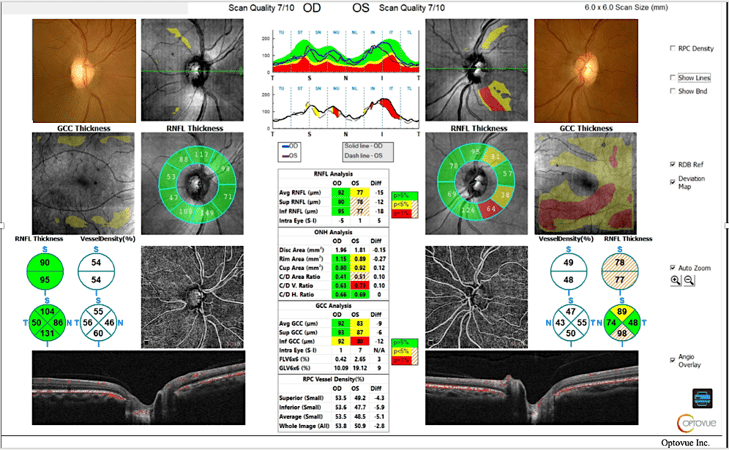Patient description
54-year-old Black female presented for comprehensive eye examination with complaints of blurry vision without her glasses. She was a Type 2 Diabetic of 6 years duration with very poor blood sugar control; her last HbA1C measured 11%. Her ocular history was positive for ocular hypertension. She had a positive family of glaucoma in a maternal aunt.
Clinical Findings
The patient’s intraocular pressure readings ranged from 22mmHg-29mmHg over the course of the last three years with a maximum IOP of 25mmHg OD and 29mmHg OS. Pachymetry measured 513 OD and 514 OS. Her optic nerve heads were pink and distinct with C/D ratios measuring .55V/.50H OD and .65V/.55H OS. Solix OCT-Angiography (OCT-A) was performed to further evaluate for the presence of glaucoma versus ocular hypertension.
Analysis of this patient’s right eye was unremarkable for the presence of glaucoma. Careful inspection of the left eye revealed thinning of the retinal nerve fiber layer inferior temporal and superior temporal to the optic nerve head. Quantitative data of the RNFL thickness corresponded with the thinning noted on the RDB map. Inspection of the tabular data shows a 15um difference in RNFL thickness and a 9um difference in GCC thickness between the right and left eyes. Of note is the large variation from the reference database in the ganglion cell thickness map of the left eye. These findings suggest that this patient may be at risk for developing glaucoma and further testing is warranted.
Conclusion
The Optovue Solix glaucoma package provides a comprehensive analysis of the optic nerve head including disc photos, retinal nerve fiber layer analysis, ganglion cell analysis, and vessel density metrics. A single scan generates both OCT and OCT-A images with AngioAnalytics metrics to accurately identify damage to the radial peripapillary capillaries and track progression over time.
 Dr. Julie Rodman is the Chief of the Broward Eye Care Institute in Fort Lauderdale, FL and a Professor of Optometry at Nova Southeastern University. Her research interests include OCT/OCT-A and Vitreoretinal Disease. Dr. Rodman has authored over thirty publications with an emphasis on retinal disease. She recently published “Optical Coherence Tomography Atlas: A Case Study Approach,” the first reference book on this topic written by an optometrist. Dr. Rodman is a member of the AOA, AAO, FOA, and ORS. She has been the recipient of numerous teaching awards and was recognized as a Primary Care Optometry News “Top 300” Optometrists and “Newsweek Best Optometrists of 2021.”
Dr. Julie Rodman is the Chief of the Broward Eye Care Institute in Fort Lauderdale, FL and a Professor of Optometry at Nova Southeastern University. Her research interests include OCT/OCT-A and Vitreoretinal Disease. Dr. Rodman has authored over thirty publications with an emphasis on retinal disease. She recently published “Optical Coherence Tomography Atlas: A Case Study Approach,” the first reference book on this topic written by an optometrist. Dr. Rodman is a member of the AOA, AAO, FOA, and ORS. She has been the recipient of numerous teaching awards and was recognized as a Primary Care Optometry News “Top 300” Optometrists and “Newsweek Best Optometrists of 2021.”
